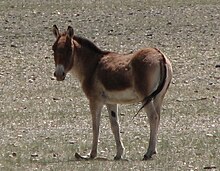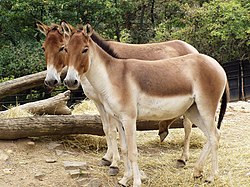en
names in breadcrumbs


Perception Channels: tactile ; chemical
Undetermined (IUCN, 1996).
Lower risk (IUCN, 2000).
However, habitat loss and competition for food sources with livestocks could put them at risk. In some areas, poaching pressure still exists.
IUCN Red List of Threatened Species: least concern
The wild asses are hunted for meat and for their skins, which are used for making leather.
Positive Impacts: food
E. kiang feed mainly on grasses and short plants. They especially feed on forbs (Stipa spp.), which are widely distributed and plentiful. Their feeding areas sometimes overlap with those of domestic sheep during summer, but they do not complete for food significantly.
Plant Foods: leaves
Primary Diet: herbivore (Folivore )
Equus kiang are wildly distributed in Tibet, Tsinghai and Szechwan regions of China, Nepal, and India. Three subspecies have been assigned to populations in different ranges, but this is still controversial.
Biogeographic Regions: palearctic (Native ); oriental (Native )
E. kiang live in alpine grass lands of elevation range from 4000 m to 7000 m. They prefer dry open areas including desert, semidesert, or steppe. Annual precipitation is from 60 mm to 70 mm.
Range elevation: 4000 to 7000 m.
Habitat Regions: temperate
Terrestrial Biomes: tundra ; desert or dune ; mountains
About 20 years.
Average lifespan
Status: captivity: 30.1 years.
Equus kiang is the largest wild ass species in the world. Kiang lengths are about 210 cm, shoulder heights are about 140 cm, tail lengths are 50 cm, and body weights are 250 to 440 kg. Their pelage changes with season. They are usually reddish in summer and dark brown in winter. In summer the coat is shorter and thinner, while the winter coat is long and thick. Equus kiang look more like horses than asses because of their short ears and large tail tufts. They are very similar to Equus hemionus genetically and physically. The mitochondrial DNA divergence between the 2 species is only 1%, and the divergence probably arose less than 500,000 years ago. Their running speed is slightly slower than E. hemionus.
Range mass: 250 to 440 kg.
Average length: 210 cm.
Other Physical Features: endothermic ; homoiothermic; bilateral symmetry
Sexual Dimorphism: sexes alike
Only wolves prey on wild asses in nature. However, going back to the early 1900s, they have been hunted for meat and skins. Since the hunting started, the geographic distribution of E. kiang has been reduced.
Known Predators:
Male E. kiang mob females and guard them from rival males. Single males follow the female herds and fight for breeding rights.
Mating System: polygynous
The breeding season is from August to September. Gestation takes almost a year, and thus young are usually born in late July to August when food is plentiful. One young is born at each birth. The baby can walk a few hours after birth. Weaing takes place after about a year, and it takes another year to reach sexual maturity.
Breeding season: August-September
Average number of offspring: 1.
Average gestation period: 12 months.
Average weaning age: 12 months.
Average age at sexual or reproductive maturity (female): 2 years.
Average age at sexual or reproductive maturity (male): 2 years.
Key Reproductive Features: seasonal breeding ; gonochoric/gonochoristic/dioecious (sexes separate); sexual
Average gestation period: 299 days.
Parental Investment: precocial ; female parental care
The kiang (Equus kiang) is the largest of the Asinus subgenus. It is native to the Tibetan Plateau in Ladakh, northern Pakistan, Tajikistan, China and northern Nepal. It inhabits montane grasslands and shrublands. Other common names for this species include Tibetan wild ass, khyang and gorkhar.

The kiang is the largest of the wild asses, with an average height at the withers of 140 cm (55 in). They range from 132 to 142 cm (52 to 56 in) high at the withers, with a body 182 to 214 cm (72 to 84 in) long, and a tail of 32 to 45 cm (13 to 18 in). Kiangs have only slight sexual dimorphism, with the males weighing from 350 to 400 kg (770 to 880 lb), while females weigh 250 to 300 kg (550 to 660 lb). They have a large head, with a blunt muzzle and a convex nose. The mane is upright and relatively short. The coat is a rich chestnut colour, darker brown in winter and a sleek reddish brown in late summer, when the animal moults its woolly fur. The summer coat is 1.5 cm long and the winter coat is double that length. The legs, underparts, end of the muzzle, and the inside of the ears are all white. A broad, dark chocolate-coloured dorsal stripe extends from the mane to the end of the tail, which ends in a tuft of blackish brown hairs.[3]
The genus Equus, which includes all extant equines, is believed to have evolved from Dinohippus, via the intermediate form Plesippus. One of the oldest species is Equus simplicidens, described as zebra-like with a donkey-shaped head. The oldest fossil to date is ~3.5 million years old from Idaho, USA. The genus appears to have spread quickly into the Old World, with the similarly aged Equus livenzovensis documented from western Europe and Russia.[4]
Molecular phylogenies indicate the most recent common ancestor of all modern equids (members of the genus Equus) lived ~5.6 (3.9–7.8) mya. Direct paleogenomic sequencing of a 700,000-year-old middle Pleistocene horse metapodial bone from Canada implies a more recent 4.07 Myr before present date for the most recent common ancestor (MRCA) within the range of 4.0 to 4.5 Myr BP.[5] The oldest divergencies are the Asian hemiones (subgenus E. (Asinus), including the kulan, onager, and kiang), followed by the African zebras (subgenera E. (Dolichohippus), and E. (Hippotigris)). All other modern forms including the domesticated horse (and many fossil Pliocene and Pleistocene forms) belong to the subgenus E. (Equus) which diverged ~4.8 (3.2–6.5) million years ago.[6]
The kiang is closely related to the onager (Equus hemionus), and in some classifications it is considered a subspecies, E. hemionus kiang. Molecular studies, however, indicate that it is a distinct species.[7] An even closer relative, however, may be the extinct Equus conversidens of Pleistocene America,[8] to which it bears a number of striking similarities; however, such a relationship would require kiangs to have crossed Beringia during the Ice Age, for which little evidence exists. Kiangs can crossbreed with onagers, horses, donkeys, and Burchell's zebras in captivity, although, like mules, the resulting offspring are sterile. Kiangs have never been domesticated.[3]

Kiangs are found on the Tibetan Plateau, between the Himalayas in the south and the Kunlun Mountains in the north. This restricts them almost entirely to China, but numbers up to 2500 to 3000 are found across the borders in the Ladakh, Himachal Pradesh, and Uttarakhand regions of India, and smaller numbers along the northern frontier of Nepal.[9]
Three subspecies of kiangs are currently recognised:[1][3][9]
The eastern kiang is the largest subspecies; the southern kiang is the smallest. The western kiang is slightly smaller than the eastern and also has a darker coat. However, no genetic information confirms the validity of the three subspecies, which may simply represent a cline, with gradual variation between the three forms.[2][9]
Kiangs inhabit alpine meadows and steppe country between 2,700 and 5,300 m (8,900 and 17,400 ft) elevation. They prefer relatively flat plateaus, wide valleys, and low hills, dominated by grasses, sedges, and smaller amounts of other low-lying vegetation. This open terrain, in addition to supplying them with suitable forage absent in the more arid regions of central Asia, may make it easier for them to detect, and flee from, predators.[10]
Like all equids, kiangs are herbivores, feeding on grasses and sedges, especially Stipa, but also including other local plants such as bog sedges, true sedges, and meadow grasses. When little grass is available, such as during winter or in the more arid margins of their native habitat, they have been observed eating shrubs, herbs, and even Oxytropis roots, dug from the ground. Although they do sometimes drink from waterholes, such sources of water are rare on the Tibetan Plateau, and they likely obtain most of their water from the plants they eat, or possibly from snow in winter.[3]
Their only real predator other than humans is the Himalayan wolf. Kiangs defend themselves by forming a circle, and with heads down, kick out violently. As a result, wolves usually attack single animals that have strayed from the group.[11] Kiangs sometimes gather together in large herds, which may number several hundred individuals. However, these herds are not permanent groupings, but temporary aggregations, consisting either of young males only, or of mothers and their foals. Older males are typically solitary, defending a territory of about 0.5 to 5 km2 (0.19 to 1.93 sq mi) from rivals, and dominating any local groups of females. Territorial males sometimes become aggressive towards intruders, kicking and biting at them, but more commonly chase them away after a threat display that involves flattening the ears and braying.[3]
Kiangs mate between late July and late August, when older males tend reproductive females by trotting around them, and then chasing them prior to mating. The length of gestation has been variously reported as seven to 12 months, and results in the birth of a single foal. Females are able to breed again almost immediately after birth, although births every other year are more common. Foals weigh up to 35 kg (77 lb) at birth, and are able to walk within a few hours. The age of sexual maturity is unknown, although probably around three or four years, as it is in the closely related onager. Kiang live for up to 20 years in the wild.[3]
Natural historian Chris Lavers points to travellers' tales of the kiang as one source of inspiration for the unicorn, first described in Indika by the Ancient Greek physician Ctesias.[12]
Ekai Kawaguchi, a Japanese monk who traveled in Tibet from July, 1900 to June 1902, reported:

Thubten Jigme Norbu, the elder brother of Tenzin Gyatso the 14th Dalai Lama, reporting on his trip from Kumbum Monastery in Amdo to Lhasa in 1950, said:

The kiang (Equus kiang) is the largest of the Asinus subgenus. It is native to the Tibetan Plateau in Ladakh, northern Pakistan, Tajikistan, China and northern Nepal. It inhabits montane grasslands and shrublands. Other common names for this species include Tibetan wild ass, khyang and gorkhar.